ASP.NET MVC5验证系列之服务端验证
这篇文章,我将会说到,使用数据注解API来进行服务端验证。ASP.NET MVC 框架在执行的时候,验证所有传递到控制器的数据,如果验证失败就把错误消息,填充到ModelState对象中,并且把这个对象传递给控制器,然后控制器中的方法,根据Modelstate的状态来判断,是否验证失败还是验证通过。
在这里,我将会使用两种方法来验证数据的合法性,一个是手动添加错误消息到ModelState对象中,另外一个方法是使用数据注解【Data Annotation】 API,来做。
先来看看使用手动验证的方式吧:
我们新建一个空白的MVC项目:添加一个Student实体:
using System;
using System.Collections.Generic;
using System.Linq;
using System.Web;
namespace Server_Side_Validation_IN_MVC.Models
{
public class Student
{
public string Name { get; set; }
public string Email { get; set; }
}
}
然后添加一个Student控制器:
using Server_Side_Validation_IN_MVC.Models;
using System;
using System.Collections.Generic;
using System.Linq;
using System.Text.RegularExpressions;
using System.Web;
using System.Web.Mvc;
namespace Server_Side_Validation_IN_MVC.Controllers
{
public class StudentController : Controller
{
// GET: Student
public ActionResult Index()
{
return View();
}
[HttpPost]
public ActionResult Index(Student model)
{
//服务端验证,方法一,手动添加错误消息到ModelState对象中
//如果Name是空的
if (string.IsNullOrEmpty(model.Name))
{
ModelState.AddModelError("Name", "Name is required");
}
//如果Email是空的
if (string.IsNullOrEmpty(model.Email))
{
ModelState.AddModelError("Email", "Email is required");
}
else
{
string emailRegex = @"^([a-zA-Z0-9_\-\.]+)@((\[[0-9]{1,3}" +
@"\.[0-9]{1,3}\.[0-9]{1,3}\.)|(([a-zA-Z0-9\-]+\" +
@".)+))([a-zA-Z]{2,4}|[0-9]{1,3})(\]?)$";
Regex re = new Regex(emailRegex);
//Email不为空的时候,但格式不合法
if (!re.IsMatch(model.Email))
{
ModelState.AddModelError("Email", "Email is not valid");
}
}
//实体验证通过
if (ModelState.IsValid)
{
ViewBag.Name = model.Name;
ViewBag.Email = model.Email;
}
return View(model);
}
}
}
创建Index视图:
@model Server_Side_Validation_IN_MVC.Models.Student
@{
Layout = null;
}
<!DOCTYPE html>
<html>
<head>
<meta name="viewport" content="width=device-width" />
<title>Index</title>
</head>
<body>
<div>
@using (Html.BeginForm())
{
//使用ViewData.ModelState.IsValid来判断ModelState的状态
if (ViewData.ModelState.IsValid)
{
if (ViewBag.Name != null)
{
<b>
Name:@ViewBag.Name<br/>
Email:@ViewBag.Email
</b>
}
}
<fieldset>
<legend>Student</legend>
<div>
@*生成label标签*@
@Html.LabelFor(model=>model.Name)
</div>
<div>
@*生成文本框*@
@Html.EditorFor(model=>model.Name)
@*不合法*@
//// @if (!ViewData.ModelState.IsValid)//这样写有问题正确的写法: @if (!ViewData.ModelState.IsValid &&ViewData.ModelState["Email"].Errors.Count>0)
【本文来源:http://www.1234xp.coml转载请保留出处】 {
//从字典中获取错误消息:@ViewData.ModelState["Name"].Errors[0].ErrorMessage
<span style="color:red">@ViewData.ModelState["Name"].Errors[0].ErrorMessage</span>
}
</div>
<div>
@Html.LabelFor(model=>model.Email)
</div>
<div>
@Html.EditorFor(model=>model.Email)
/////@if (!ViewData.ModelState.IsValid) 这样写有问题: // 正确的写法在下面 @if (!ViewData.ModelState.IsValid &&ViewData.ModelState["Email"].Errors.Count>0)
{
//从字典中获取错误消息:@ViewData.ModelState["Email"].Errors[0].ErrorMessage
<span style="color:red">@ViewData.ModelState["Email"].Errors[0].ErrorMessage</span>
}
</div>
<p>
<input type="submit" value="Create"/>
</p>
</fieldset>
}
</div>
</body>
</html>
然后,修改一下默认的路由:
public static void RegisterRoutes(RouteCollection routes)
{
routes.IgnoreRoute("{resource}.axd/{*pathInfo}");
routes.MapRoute(
name: "Default",
url: "{controller}/{action}/{id}",
defaults: new { controller = "Student", action = "Index", id = UrlParameter.Optional }
);
}
运行之后,报错。查找了一下原因,修改了一下视图代码:

运行之后,

接着验证一下,Name不为空,Email输入非法格式的数据:

最后验证一下,输入合法的数据:

好了,现在看看第二种方式,使用数据注解来进行服务端验证:
新建一个类:避免混淆,
using System;
using System.Collections.Generic;
using System.ComponentModel.DataAnnotations;
using System.Linq;
using System.Web;
namespace Server_Side_Validation_IN_MVC.Models
{
public class StudentServer
{
[Required(ErrorMessage="Name为必填项")]
public string Name { get; set; }
[Required(ErrorMessage="电子邮件必须")]
[EmailAddress(ErrorMessage="电子邮件格式不对")]
public string Email { get; set; }
}
}
在控制器中新建两个方法:
public ActionResult SeverSideIndex()
{
return View();
}
[HttpPost]
public ActionResult SeverSideIndex(StudentServer model)
{
if (ModelState.IsValid)
{
ViewBag.Name = model.Name;
ViewBag.Email = model.Email;
}
return View();
}
对应的视图:
@model Server_Side_Validation_IN_MVC.Models.StudentServer
@{
Layout = null;
}
@if (ViewData.ModelState.IsValid)
{
if (ViewBag.Name != null)
{
<b>
Name:@ViewBag.Name<br />
Email:@ViewBag.Email
</b>
}
}
<!DOCTYPE html>
<html>
<head>
<meta name="viewport" content="width=device-width" />
<title>SeverSideIndex</title>
</head>
<body>
<div>
@using (Html.BeginForm())
{
@Html.ValidationSummary(true)
<fieldset>
<legend>Student</legend>
<div>
@Html.LabelFor(model=>model.Name)
</div>
<div>
@Html.EditorFor(model=>model.Name)
@Html.ValidationMessageFor(model=>model.Name)
</div>
<div>
@Html.LabelFor(model => model.Email)
</div>
<div>
@Html.EditorFor(model => model.Email)
@Html.ValidationMessageFor(model => model.Email)
</div>
<p>
<input type="submit" value="Create"/>
</p>
</fieldset>
}
</div>
</body>
</html>

首先验证,都为空的情况:

Name不为空,Email为空

Name不为空,Email输入非法格式数据

两个都输入合法的数据:

好了,以上就是MVC中服务端验证了,我们一般是使用第二种,来进行验证。也就是数据注解。
以上就是本文的全部内容,希望对大家的学习有所帮助,也希望大家多多支持海外IDC网。
